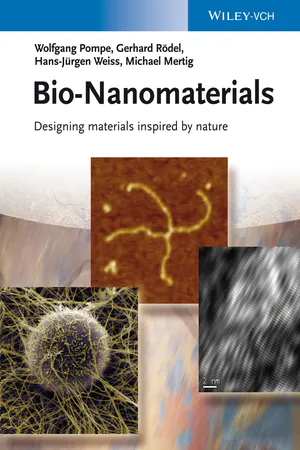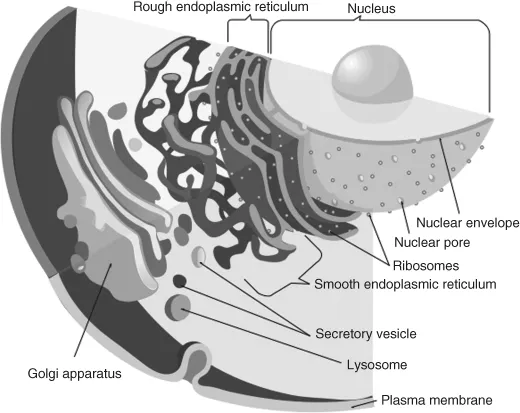
eBook - ePub
Bio-Nanomaterials
Designing Materials Inspired by Nature
This is a test
- English
- ePUB (mobile friendly)
- Available on iOS & Android
eBook - ePub
Bio-Nanomaterials
Designing Materials Inspired by Nature
Book details
Book preview
Table of contents
Citations
About This Book
Written by authors from different fields to reflect the interdisciplinary nature of the topic, this book guides the reader through new nano-materials processing inspired by nature.
Structured around general principles, each selection and explanation is motivated by particular biological case studies. This provides the background for elucidating the particular principle in a second section. In the third part, examples for applying the principle to materials processing are given, while in a fourth subsection each chapter is supplemented by a selection of relevant experimental and theoretical techniques.
Frequently asked questions
At the moment all of our mobile-responsive ePub books are available to download via the app. Most of our PDFs are also available to download and we're working on making the final remaining ones downloadable now. Learn more here.
Both plans give you full access to the library and all of Perlego’s features. The only differences are the price and subscription period: With the annual plan you’ll save around 30% compared to 12 months on the monthly plan.
We are an online textbook subscription service, where you can get access to an entire online library for less than the price of a single book per month. With over 1 million books across 1000+ topics, we’ve got you covered! Learn more here.
Look out for the read-aloud symbol on your next book to see if you can listen to it. The read-aloud tool reads text aloud for you, highlighting the text as it is being read. You can pause it, speed it up and slow it down. Learn more here.
Yes, you can access Bio-Nanomaterials by Wolfgang Pompe,Gerhard Rödel,Hans-Jürgen Weiss,Michael Mertig in PDF and/or ePUB format, as well as other popular books in Technologie et ingénierie & Nanotechnologie et MEMS. We have over one million books available in our catalogue for you to explore.
Information
1
Molecular Units
1.1 Case Studies
Living beings are “open” systems whose sustained existence requires fluxes. Since even very simple open systems such as a candle flame or a water jet form their own shape and restore it after a disturbance, one may readily accept the idea that more complex open systems are able to form and sustain more complex structures in space and time. Apparently, there are open systems involving chemical reactions with a tendency toward the formation of substances and reaction cycles with increasing complexity, ending up in the formation of life. The molecular processes of life are usually confined to enclosed (but not closed) spaces, the cells and their internal compartments. Eukaryotic cells, which are discriminated from prokaryotic cells by the presence of a nucleus harboring the vast majority of genetic information, are equipped with a variety of such functionally defined compartments, collectively summarized as organelles (Figure 1.1). This type of confinement is realized by membranes shielding the interior and controlling the flow of substances, energy, and information in and out. The information flow is facilitated by the membranes' capability of signal detection and transduction. Structural flexibility of the plasma membrane is a necessary precondition for cell motility and division. The cell is filled with cytoplasm, an assembly of functional entities and filamentous networks immersed in an aqueous solution, the cytosol.
Figure 1.1 Eukaryotic cell structure with the endomembrane system.(Source: Wikimedia Commons; author Mariana Ruiz.)

Since there are good reasons for the assumption that all organisms have descended from a hypothetical common progenitor, their relationship has the topology of a tree and hence is usually visualized as a graph known as the phylogenetic tree of life (Figure 1.2). One can be sure that the tree of life obtained with a particular advanced technique, as the one in Figure 1.2, does not much differ from the real one and thus can serve as a basis for considerations as if it were the real one. As seen in the figure, the tree of life consists of three major domains. The vast majority of organisms are unicellular. Multicellular species are only found in a few branches of the Eukaryota, which are distinguished by the presence of a nucleus containing most of the genetic information. Autotrophic and heterotrophic organisms are present in every major domain. These terms refer to the source of the energy-rich organic substances (nutrients) required to drive the metabolism. Autotrophic organisms are able to produce the nutrients by themselves, starting from inorganic substances. In contrast, heterotrophic organisms are unable to synthesize their nutrients and hence have to acquire them by consuming organic substances. Besides the well-known photoautotrophy of plants, an alternative form of autotrophy, the so-called chemoautotrophy, is widespread among the Prokaryota. In the presence of oxygen, chemoautotrophic organisms make use of the energy released by oxidation, notably of inorganic substances, enabling them to live in extreme habitats such as salt lakes, hot springs, deep sea floors, and so on. This property makes chemoautotrophs interesting for bioengineering. Photoautotrophic cyanobacteria have recently been considered with respect to their suitability for biofuel production. Eukaryotes are especially valuable for biotechnology, bio-inspired materials development, and medical engineering. Fermentation by means of yeast, for example, has been applied for millennia. Recently, animal stem cells have been widely used in tissue engineering developments. The huge variety of organisms offers a wealth of objects with structures differing on the molecular level that may be suitable as building blocks in biotechnology and biologically inspired materials science. Today, we are still in a very early stage of exploring their potential. Our responsibility for the protection of life on Earth implies that progress in this field of research should always be complemented with adequate risk assessment.
Figure 1.2 The phylogenetic tree of life based on the comparison of ribosomal RNA. (Bacteria and Archaea are also called Prokaryota. The names of most taxa are omitted here for simplicity.)

The sizes of the bimolecular structures investigated as potential building blocks range from molecular (0.2 nm) to cell size (0.1 mm) (Figure 1.3). Remarkably, organisms utilize only a small fraction of the chemical elements. Obviously, they are sufficient to form the large variety of organic compounds required for sustaining the processes of life. Let us consider the composition of the bacterium Escherichia coli, with size is about 2 μm × 1 μm (Table 1.1). Its cytoplasm contains the nucleoid usually with one DNA chain, eventually a few small circular DNA molecules called plasmids, about 15 000 ribosomes (the sites of protein synthesis), 10 to several hundred copies of about 1000 different enzymes, about 1000 smaller organic compounds with a molecular weight less than 1000 (metabolites or coenzymes), and various inorganic ions. The cytoplasm is surrounded by the cell envelope, which consists of an outer and an inner membrane composed of lipid bilayers and peptidoglycans. Connected to the envelope are specific protein structures such as flagellae for cell propelling, pili providing adhesion sites, and surface layer proteins for mechanical stabilization and acting as filter and ion transport structures.
Figure 1.3 Size variation of biological components.

Table 1.1 Molecular composition of E. coli according to Nelson and Cox (2008)
| Percentage of total cellular weight | Approximate number of different molecular species | |
| Water | 70 | 1 |
| Proteins | 15 | 3000 |
| Nucleic acids | ||
| DNA | 1 | 1–4 |
| RNA | 6 | >3000 |
| Polysaccharides | 3 | 10 |
| Lipids | 2 | 20 |
| Monomeric subunits and intermediates | 2 | 500 |
| Inorganic ions | 1 | 20 |
Eukaryotic cells with a size of about 5–100 μm show a higher structural complexity. The essential differences to bacteria are the presence of a nucleus, a number of membrane-enclosed organelles (e.g., mitochondria, endoplasmic reticulum, Golgi complexes, peroxisomes, and lysosomes), and the cytoskeleton, a highly structured network of protein filaments (microtubules, actin filaments, and intermediate filaments) organized by numerous proteins that regulate the assembling and disassembling of the various filaments. Characteristic components of plant cells are chloroplasts and vacuoles. A concise overview of the s...
Table of contents
- Cover
- Related Titles
- Title Page
- Copyright
- Preface
- Chapter 1: Molecular Units
- Chapter 2: Molecular Recognition
- Chapter 3: Cell Adhesion
- Chapter 4: Whole-Cell Sensor Structures
- Chapter 5: Biohybrid Silica-Based Materials
- Chapter 6: Biomineralization
- Chapter 7: Self-Assembly
- Appendix A: Constants, Units, and Magnitudes
- Appendix B: Energy of a Bent Fiber
- Appendix C: Circular Dichroism Spectroscopy
- Appendix D: Task Solutions
- Index